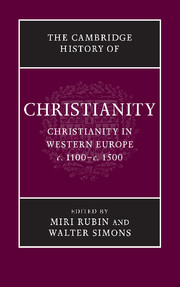Book contents
- Frontmatter
- Introduction
- PART I INSTITUTIONS AND CHANGE: 1100–1200
- PART II FORGING A CHRISTIAN WORLD, 1200–1300
- PART III THE ERECTION OF BOUNDARIES
- PART IV SHAPES OF A CHRISTIAN WORLD
- PART V CHRISTIAN LIFE IN MOVEMENT
- PART VI THE CHALLENGES TO A CHRISTIAN SOCIETY
- PART VII REFORM AND RENEWAL
- Select bibliography
- Index
- Map 1 Western Europe c. 1100 – c. 1500
- Map 2 Universities of Europe
Introduction
Published online by Cambridge University Press: 28 March 2010
- Frontmatter
- Introduction
- PART I INSTITUTIONS AND CHANGE: 1100–1200
- PART II FORGING A CHRISTIAN WORLD, 1200–1300
- PART III THE ERECTION OF BOUNDARIES
- PART IV SHAPES OF A CHRISTIAN WORLD
- PART V CHRISTIAN LIFE IN MOVEMENT
- PART VI THE CHALLENGES TO A CHRISTIAN SOCIETY
- PART VII REFORM AND RENEWAL
- Select bibliography
- Index
- Map 1 Western Europe c. 1100 – c. 1500
- Map 2 Universities of Europe
Summary
Medieval Christian Europe has long been acknowledged as a place and a time central to the formation of the Christian heritage. Until recently it was still described in popular and learned books alike as the ‘age of faith’, a time of intense religious feeling and extravagant action in the pursuit of religious goals: crusade, inquisition, scholastic theology and mysticism. It was an age characterised by an imposing public Christian art and the institutions of the papacy in the lead. Until recent decades the study of medieval European Christianity was based primarily on Latin texts: theological tracts, canon law and its commentaries, and some devotional tracts. The protagonists of medieval European Christianity were popes, bishops, reforming abbots and activist preachers; its spaces were envisaged as monasteries, cathedrals and universities. While Europe’s tens of thousands of parishes were still in evidence, the quality of religion in them excited relatively little interest: provision for them being either sparse, or merely a diluted version of the official and learned formulations of scholars, popes and bishops.
This volume of The Cambridge History of Christianity offers the reader a series of articles that summarises some of the exciting, imaginative and transformative historical work on the religious cultures inhabited by Western Europeans between 1100 and 1500. It cannot encompass all areas of current research but it offers introductory essays to a vast range of subjects, with the expectation that the interested reader will go on to pursue more.
- Type
- Chapter
- Information
- The Cambridge History of Christianity , pp. 1 - 8Publisher: Cambridge University PressPrint publication year: 2009



